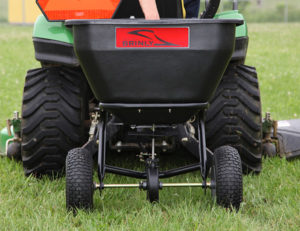
Picture yourself towing a fertilizer spreader that flawlessly applies grass seed, fertilizer, and other materials throughout your lawn.
When you upgrade to the best fertilizer spreader, you can make that image come to life.
In this blog post, you’ll learn how to find your next best fertilizer spreader:
· 5 tips for finding fertilizer spreaders: Which one’s best for you?
· Easy steps for finding the best lawn fertilizer for your area.
· Foolproof hacks for fertilizing your spring lawn.
5 Tips for Finding Fertilizer Spreaders: Which One’s Best for You?
Where do you start when it comes to finding the best fertilizer spreader for your lawn? There are five spreader types to consider:
Each fertilizer spreader performs best based on your budget, calibration, lawn size and shape, spreader features, and the materials being spread.
Consider a rotary spreader if you have a large lawn or are new to lawn fertilization. It will give you broad coverage in minimal time and reduce overapplication.
Watch more: Will It Spread in a Brinly Spreader?
When choosing the best fertilizer spreader, you also want to know the unique thing that sets each spreader apart, such as
· Hand-held spreaders work best for tight or small areas
· Push spreaders work best on mid-size lawns
· Tow-behind spreaders work best on large lawns
· If you’re new to spreading fertilizer, grass seed, and other materials, you can’t go wrong with a drop spreader for accuracy and coverage.
Easy Steps for Finding the Best Lawn Fertilizer for Your Area
When finding the best lawn fertilizer, you must first determine your soil’s health, which you can do through a soil test. While you can buy soil tests at your garden retailer, getting your soil tested through your local extension service is more accurate.
For example, you can buy soil test kits for $10 at your local Penn State University Extension Office, and you will receive your results within 7 to 10 business days.
The test results will show what’s missing in your soil as well as its pH. For example, if the soil is too alkaline, you’ll need to sour it with pellet lime to make it more acidic.
Your soil results should also suggest what fertilizer you need for a robust, healthy lawn. This article explains soil health in more detail.
Read more: What Type of Lawn Spreader is Best?
Foolproof Hacks for Fertilizing Your Spring Lawn
Now that you know your soil’s needs, you can take that information with you when picking up bags of fertilizer. Ensure you follow the manufacturer’s instructions on the bag to prevent burning your lawn. Remember, more is not better.
If you have a cool season lawn, you must fertilize four times during the growing season. Your last fertilizer application should be in the fall.
Meanwhile, warm season lawns require monthly fertilizer applications to ensure consistent grass growth throughout the season.
Lawn care pros will tell you that a mix of liquid and dry fertilizers will boost your grass’s health. Liquid fertilizers work for quick green-ups, while dry fertilizers, which are water-soluble, slowly release nutrients over 4 to 6 weeks.
Learn how to Calibrate Your Fertilizer Spreader
You need the best fertilizer spreader for your lawn to broadcast dry fertilizers. We recommend our Brinly fertilizer spreaders for application, including
· 125 Lb. Tow-Behind Broadcast Spreader
· 125 Lb. Tow-Behind Deluxe Spreader with Extended Handle and Cover
· 175 Lb. Tow-Behind Deluxe Spreader with Extended Handle and Cover
· 175 Lb. Tow-Behind Spreader
· 50 Lb. Push Spreader with Deflector Kit
· 50 Lb. Push Spreader
· 5 Lb. Capacity Handheld Spreader.
Grab Your Best Fertilizer Spreader Today!
Spring has arrived, so grab one of these spreaders today. You can find your best fertilizer spreader at these retailers.
Need help? Contact customer support.
Sources:
Lowes.com, Find the Best Spreader for Fertilizer, Grass Seed, and More.
LoveYourLandscape.org, Fertilizing 101.
